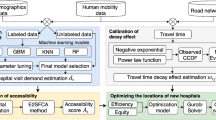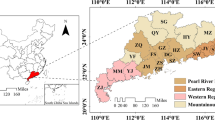Abstract
Health resource planning is an important means for the government to adjust resource allocation and achieve fair and efficient development of health. Its core is the balanced allocation of health resources. In order to solve the problem of low accuracy of health resource demand prediction, an analysis method of health resource allocation equilibrium based on improved machine learning was designed. Using the two-step mobile search method, combined with the Gaussian distance attenuation function and the search threshold set according to the classification of medical facilities, the spatial accessibility of weekday medical services is calculated. Based on the improved machine learning, the demand for health resources is predicted, and the change of resource characteristics and relevant policy variables leads to the change of health resource demand. According to the prediction results of the demand for health care resources, a supply-demand coordination model is constructed to measure the degree of coupling and coordination and the level of hierarchy. Lorentz curve was used to quantify the accessibility distribution of medical resources, Gini coefficient and global Moran index were calculated, and the equilibrium of health resource allocation was analyzed. The results show that this method can accurately predict the demand for health resources, and get the analysis results of allocation balance, which is conducive to the overall integration of medical resources.
Access this chapter
Tax calculation will be finalised at checkout
Purchases are for personal use only
Similar content being viewed by others
References
Li, X.-w, Zhu, W.: Equity evaluation of health resource allocation in Traditional Chinese Medicine hospitals in Henan. Mod. Preventive Med. 48(17), 3157–3161 (2021)
Jiang, Y.-c., Yang, Y.-q., Wang, Z.-z.: Equilibrium of resource allocation in local health standardization in China: a cross-sectional survey among provincial level CDCs. Chinese J. Public Health 38(6), 730–733 (2022)
Rodrigues, T.F., Nogueira, K., Chiarello, A.G.: Noninvasive low-cost method to identify armadillos’ burrows: a machine learning approach. Wildl. Soc. Bull. 45(3), 396–401 (2021)
Dang, A.T., Tsujimura, M., Ha, N.T., et al.: Evaluating the predictive power of different machine learning algorithms for groundwater salinity prediction of multi-layer coastal aquifers in the Mekong Delta, Vietnam. Ecol. Ind. 127(1), 107–120 (2021)
Hou, J., Zhang, G.-y.: Dynamic scheduling simulation of massive fragment resources based on cloud computing. Comput. Simulation 37(1), 360–364 (2020)
Tian, H., Zhu, J., He, X., et al.: Using machine learning algorithms to estimate stand volume growth of Larix and Quercus forests based on national-scale Forest Inventory data in China. Forest Ecosystems 9(3), 396–406 (2022)
Huang, W., Tian, K.: Current status and equity of regional health care resource allocation in Jiangsu Province. China Med. Administration Sci. 12(2), 23–27 (2022)
Jain, D.K., Kalyanapusrinivas, A., Srinivasu, S., et al.: Machine learning based monitoring system with IoT using wearable sensors and Pre-convoluted Fast Recurrent Neural Networks (P-FRNN). IEEE Sens. J. 21(22), 25517–25524 (2021)
Zhou, T.: Analysis of the characteristics of spatial and hierarchical differentiation and its driving mechanism of urban and rural medical resources in Chongqing. Chin. Health Service Manag. 39(4), 275–279,300 (2022)
Wang, H., Luo, L., Yu, C.: Research on the planning completion rate and disequilibrium of health resource allocation in Guangxi in 2015–2019. Chinese Hospitals 25(11), 20–23 (2021)
Penido, E.K., Paixa, R.C.F.D., Costa, L.C.B., et al.: Predicting the compressive strength of steelmaking slag concrete with machine learning - Considerations on developing a mix design tool. Constr. Build. Mater. 341(25), 1–10 (2022)
Huang, M.C., Xu, H.Y., Yu, H.: Fast prediction of methane adsorption in shale nanopores using kinetic theory and machine learning algorithm. Chem. Eng. J. 446(3), 1–12 (2022)
Funding
Xiamen Institute of Technology 2021 School-level Young and Middle-aged Scientific Research Fund Project: Binhai Nuclear Power Plant Disaster-Causing Organisms—Detection and Identification of Haitigua, Project No. 6
Author information
Authors and Affiliations
Corresponding author
Editor information
Editors and Affiliations
Rights and permissions
Copyright information
© 2023 ICST Institute for Computer Sciences, Social Informatics and Telecommunications Engineering
About this paper
Cite this paper
Wang, Y., Li, H. (2023). Analysis on the Balance of Health Care Resource Allocation Based on Improved Machine Learning. In: Wang, S. (eds) IoT and Big Data Technologies for Health Care. IoTCare 2022. Lecture Notes of the Institute for Computer Sciences, Social Informatics and Telecommunications Engineering, vol 501. Springer, Cham. https://doi.org/10.1007/978-3-031-33545-7_8
Download citation
DOI: https://doi.org/10.1007/978-3-031-33545-7_8
Published:
Publisher Name: Springer, Cham
Print ISBN: 978-3-031-33544-0
Online ISBN: 978-3-031-33545-7
eBook Packages: Computer ScienceComputer Science (R0)




